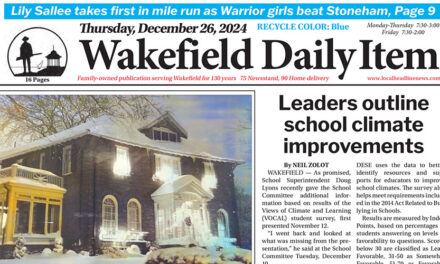Published November 18, 2020

By MARK SARDELLA
WAKEFIELD — Last night’s Planning Board Meeting featured a continued discussion of the properties at the head of the Lake, their potential for development and what forms that might take.
The meeting led off with a continued public hearing on Town Meeting articles spearheaded by the Friends of Lake Quannapowitt designed to change the zoning to prevent or limit development around the Lake. The articles were in response to a proposal by Cabot Cabot & Forbes to build 485 units of housing in two buildings on the site of the former American Mutual/Comverse building at 200 Quannapowitt Parkway.
The articles were filed in time for the Nov. 7 Town Meeting but were not acted upon because the Planning Board continued its Nov. 5 public hearing on the articles and did not issue the required recommendation for Town Meeting action.
In the interim, acting on behalf of Cabot Cabot & Forbes and the owners of two adjacent properties, attorney Brian McGrail filed ANR (Approval Not Required) plans and preliminary subdivision plans for all of the properties. Because they met all applicable regulations, the Planning Board was required to accept the plans.
That legal maneuver effectively freezes the current zoning of those properties for up to eight years. Still, the Planning Board went ahead with last night’s continued public hearing on FOLQ’s measures to try to change the zoning, which now appear to have been consolidated into one proposed zoning amendment.
What ensued was a lengthy discussion between the board and Bill Conley of FOLQ regarding the applicable sections of the Zoning Bylaws, with little agreement except that the bylaws were confusing and possibly contradictory.
Conley suggested forwarding FOLQ’s proposed bylaw changes to Town Counsel Thomas Mullen for clarification and suggestions.
But Planning Board member Matthew Lowry questioned exactly what Mullen would be asked to do. If it was to get clarity on zoning, that would be one thing, he said.
“But for him to help write the article,” Lowry added, “that’s not his role.”
McGrail pointed out that the proposed FOLQ zoning amendment was based on a zoning district that does not exist on the Wakefield Zoning Map.
Lowry observed that there were still a lot of things that need to be worked out with respect to FOLQ’s proposed zoning amendment, which was why he was concerned when it was proposed at the last minute before the Nov. 7 Town Meeting that it was being rushed through without time for proper review.
Planning Board member Joanne Scouler asked Conley to articulate exactly what FOLQ was seeking to accomplish with the proposed zoning amendment.
Conley said that FOLQ wanted to limit the size and density of anything that might be built at the head of the Lake.
Attorney Peter Tamm, representing Cabot Cabot & Forbes, said that he was not clear as to why the Planning Board was entertaining a public hearing on a flawed zoning article.
Ultimately, Planning Board Chairman William Spaulding declared that the public hearing on FOLQ’s proposed zoning amendment would be continued to the board’s Jan. 12 meeting.
In a related matter last night, the Planning Board reviewed the previously submitted and accepted preliminary subdivision plans for 200 Quannapowitt Parkway, 50 Quannapowitt Parkway and 591, 595, 599 and 607 North Avenue (properties that include the Lakeside Office Park and the Lakeside Hotel).
The board approved the plans for 591, 595, 599 and 607 North Avenue. There was a 2-2 (with one abstention) tie on the plans for 50 Quannapowitt Parkway and the board voted not to approve the plans for 200 Quannapowitt Parkway.
McGrail pointed out that the zoning freeze for all of the properties was triggered by the filing and initial acceptance by the Planning Board of the preliminary subdivision plans and is not affected by the board’s approval or disapproval of the preliminary plans. The board’s feedback on the preliminary plans will inform the creation of the definitive subdivision plans when they are filed several months from now, he said.
McGrail noted that the filing of of the preliminary subdivision plans protects the property owner’s rights in the wake of attempts to change the zoning. As long as the plans meet all the rules, they must be approved. It does not mean that the subdivision plans will be implemented and the owners are under no obligation to do go forward with those plans.




